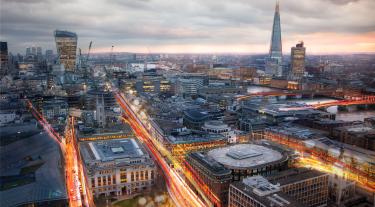There were shouts and whistles, cheers and tears. It was December 2015 and something remarkable had happened. After a tortuous process of negotiation — and against the backdrop of major companies expressing strong support for climate action — almost 200 countries backed a global plan to keep global temperature rises well below 2°C and to pursue efforts to limit them to 1.5°C.
With what’s known as the Paris Agreement in place, countries had committed to nationally-determined plans to meet this goal – from cutting fossil fuel emissions and using more solar or wind power, to putting a price on carbon pollution. Everyone celebrated.
Yet, the level of emissions reductions required across most of the economy to meet the Paris goals in full — broadly cutting them in half by 2030 and reaching net zero emissions by the middle of the century — look challenging, to say the least.
Meanwhile, experience tells us that solving our biggest global problems won't happen through international treaties alone. Nor will regulation, though important, be sufficient to tackle climate change. Plus, persuading the majority of citizens to commit to carbon reduction through personal austerity will be an uphill battle, if not impossible.
Some say enlightened self-interest is one of humankind’s most powerful motivators. If this is true, our best hope of preventing out-of-control climate change from having a catastrophic impact on lives, livelihoods and the natural world is to demonstrate the upside: to show how tackling carbon emissions can have a positive impact, not only on the planet but also on its people. What if fixing climate change could save money, create jobs and improve our lives?
This is where the private sector comes in – and it was the strong voice of companies that played one of the most significant roles in securing the Paris Agreement, helping give governments the support they needed to sign up.
In meeting the goals of the Paris Agreement, the private sector has a hugely important part to play. For without business creating products and services that have a lower environmental footprint, an increasingly prosperous global consumer base will have only one way of reducing their carbon footprint: putting a lot less stuff in the shopping cart (which seems unlikely to happen).
Supply chains follow a similar principle. For example, a cement producer or textile manufacturer will only be able to become more environmentally sustainable if the equipment the company needs to purchase has been redesigned to have a lower impact.
“Business will do the heavy lifting in the transition to a sustainable future,” says Tom Delay, Chief Executive of the Carbon Trust.
“Policymakers, regulators, standard setters are all important as they establish the markets in which businesses operate. But at the end of the day, providing the products, services and infrastructure that people want and that is far less environmentally damaging is going to be done by businesses.”
Where do you start?
For a corporate chief, this ’heavy lifting’ might sound daunting and the way forward uncertain. After all, a company in the financial services sector needs to take very different actions to address climate change from those required of a food processing company or a power generator. Then there are the basic questions. Where do you start? How far and fast do you go? How hard will the journey be?
The first question is relatively easy to answer: a journey towards becoming a low carbon business starts at home in a company’s own operations — those that take place within its own four walls. That means looking for energy savings in everything from corporate offices and vehicle fleets to factories and industrial processes, while also finding opportunities to buy or generate clean, renewable energy.
Answering the question: How far and fast do you go?’ is more complex, particularly when looking beyond a company’s own operations and into value chain sustainability. Companies must look upstream in their supply chains at the environmental footprint of the companies from which they purchase goods, services and raw materials. They must also consider what people then do with their products after sale.
The reality is that, for some companies, their biggest environmental impact occurs once their products are in the hands of consumers. This means focusing on innovation to come up with new technologies and sustainable business models.
Then there’s the question of how hard all this will be. There are certainly challenges, particularly when starting from scratch. Even companies that are now making impressive strides in lowering their carbon footprint had to start somewhere.
Take Verizon. With an ambitious 2025 goal to cut its carbon intensity in half over 2016 levels, by 2017 the telecoms company had already delivered a 28 per cent reduction. Yet at the start of Verizon’s journey, James Gowen, head of its global supply chain operations and chief sustainability officer, remembers his reaction when he was called into the then CEO’s office to discuss creating a sustainability division. “I said, ‘Yes sir’,” he recalls. “It was the opportunity of a lifetime, but at the same time I knew I was taking on an enormous challenge without an easy answer.”
Companies must work to increase understanding of climate change and its impact on business. “One of the biggest challenges for us internally and with our clients is creating a greater level of awareness around some of these climate issues,” says Daniel Klier, group head of strategy and global head of sustainable finance at HSBC. “Because while we are becoming more familiar with ESG, greenhouse gases and the Paris Agreement, these are not things that every CFO, treasurer or banker is familiar with.”
Internally, companies can also encounter resistance along the way. “Three or four years ago it was not so clear to everybody in our group how a changing climate in the second half of this century can impact today’s business and vice versa,” says Thomas Fusshöller, head of sustainability, environment and energy management at thyssenkrupp, a diversified German industrial conglomerate. “To get the organisation on board, all climate actions must be closely connected to the corporate strategy, as well as to internal and external stakeholder expectations.”
While low carbon products save money in the long run, companies need to grapple with getting the message out to their customers. “It’s hard to sell anything that’s more expensive up front,” says Mario Abreu, vice-president of sustainability at Tetra Pak, a leading food processing and packaging company. “Our customers are interested in reducing energy and costs, but they’re also interested in reducing initial capital investment.”
Meanwhile, a tricky balance must be struck between carbon-efficiency and growth, says Joan Krajewski, general manager of safety, compliance and sustainability at Microsoft. “We’re on track to meet our emissions reduction, but we really need to continue to make progress on buying more renewable energy, supporting government policies that encourage the development of renewable energy and expanding our R&D efforts in reducing our data centre carbon footprint,” she says. “It’s definitely a multi-headed programme.”
Business benefits
So, given the hurdles, why push on? The answer goes beyond the altruistic instincts of corporate leaders. A desire to behave responsibly is certainly a factor. However, leading companies have discovered that they can do the right thing for the planet and do the right thing for their company’s bottom line.
The potential rewards are manifold — from preparing operations to meet future environmental regulations to fostering innovation, attracting new customers and investors, or increasing appeal among talented recruits who want to work for a company that’s doing the right thing.
Often the rewards are in the form of cash savings. Take BT, the UK-based telecoms giant. In 2018 alone, the company saved £28.7 million on its fuel and energy bill adding to a total saving of £250.7 million since it started its energy-saving programme in 2008/9.
When you put together the emissions savings of thousands of other companies doing similar things, this soon adds up. This is clear from data collected by CDP, the global non-profit whose global disclosure system enables companies, cities, states and regions to measure and manage their environmental impacts.
Through CDP’s supply chain programme, almost 100 of the world’s largest companies, with US$3 trillion in purchasing power, collected data from more than 4,800 of their suppliers in 2017. These suppliers reported emissions reductions equivalent to 551 million tonnes of carbon dioxide — more than Brazil’s total emissions in 2016, with cost savings amounting to US$14 billion.
Then there’s what we see around us — hotter temperatures, more extreme weather events and ecosystems that are being degraded. Something is clearly happening to our climate and we need to address it urgently.
This has helped to inspire around 500 companies to support the implementation of the Paris Agreement by adopting their own science-based targets. These allow companies to set greenhouse gas emission reduction goals that are in line with climate science (the Science Based Targets initiative helps companies to set the right goals and highlights best practices). These goals can go beyond the minimum viable level of ambition. For example, BT worked with the Carbon Trust to become one of the world’s first companies to set a science-based target aligned with a 1.5°C pathway.
With many having tied their ambitious climate strategies to the best available climate science, the corporate leaders interviewed for this article demonstrate that while there are challenges in working to reduce the carbon footprint of an enterprise, they are not insurmountable. Addressing climate change helps tackle a number of other environmental challenges and resource constraints, while also uncovering opportunities to make a business more resilient and competitive.
Read the full series
Part 1 - A time for corporate climate action
Part 2 - First steps in emissions reductions: energy efficiency in your own operations
Part 3 - Big benefits await those who tackle supply chain emissions
Part 4 - New climate opportunities are downstream
Part 5 - Power of the people: engaging your stakeholders on climate change



